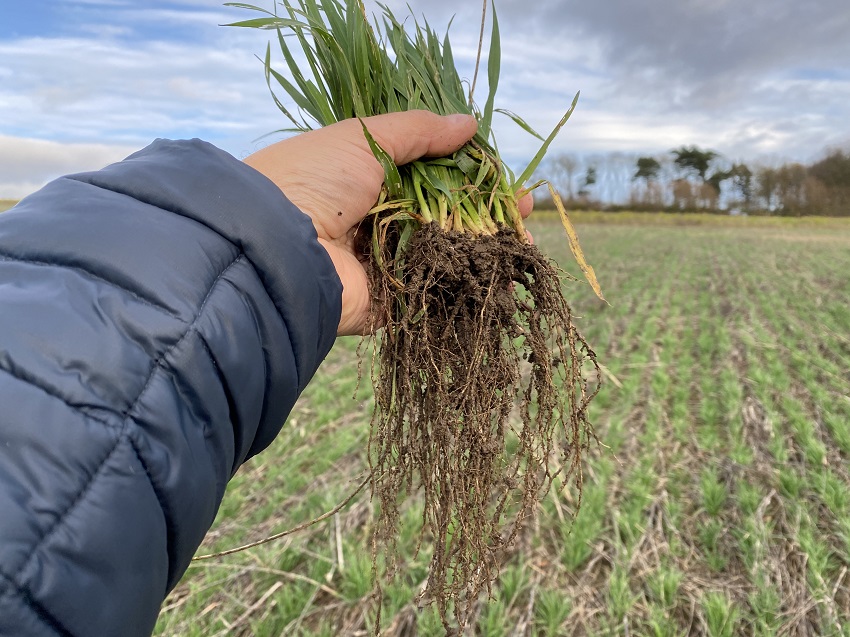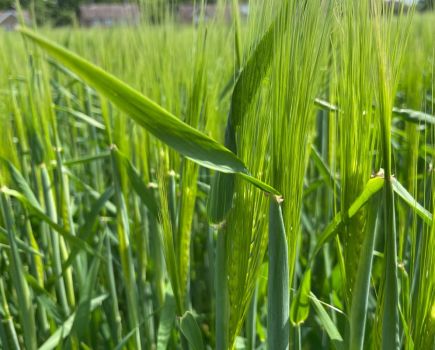As the winter months begin to draw to a close, focusing on root structure and plant health is key to producing high-yielding crops.
CPM spoke to Stuart Sutherland, Interagro’s technical manager, to get an insight into how growers can put themselves in the strongest position as we edge towards the spring.
Q.What are the key pressures facing growers as we come out of winter?
A. Thankfully, winter cropping is in a much better place than it was last year, with a resurgence in wheat and barley to near normal levels, according to the latest Early Bird Survey conducted by the Andersons Centre in Dec.
Wheat is forecast at 1776k ha and winter barley at 389k ha for harvest 2021, following better autumn drilling conditions compared with last year.
So, while we’ve had some record-breaking rainfall in the autumn, so far it’s not been as dramatic as it was this time last year, and crops are in pretty good shape.
However, we’ve a while to go yet before we’re through winter, particularly as last Feb was when we really saw high levels of rainfall. A big fundamental to high yielding crops is root structure and sunlight capture, so the key focus out of winter ought to be on:
- Root enhancement:
By the end of February, the benchmark for wheat establishment is 70%, and 260 plants/m2 – though plant damage over winter can occur from poor rooting and water logging, pest and disease damage, or frost heave.
Some fields across the country have had considerable rainfall on already saturated soils which may have impacted rooting, though short-lived flash floods after a downpour seldom harm most plants.
It’s prolonged, saturated soil that causes the most damage, as oxygen gets used up by the plant roots and soil microorganisms. Root function therefore becomes reduced, or stops, and roots can start to die off, resulting in above ground symptoms to leaves and stems as they become unable to obtain any water or nutrients to move around the plant.
So come end Feb, any crops which have been sat in water for some time are likely to have suffered root and shoot damage and require treatment to stimulate growth.
- Stress recovery:
Any winter-sown crops sat in wet waterlogged soils will have suffered water stress, which will impact productivity. Flooding reduces respiration, damages roots and reduces nutrient movement – it can reduce leaf size and leaf area and limit the plant’s ability to photosynthesise impeding crop growth, when really out of winter, it will be essential for crops to be in good health to maximise early growth and set up the crop to yield. These crops will no doubt be in need of some TLC to improve plant health as we move into spring.
- Leaf and tiller survival:
Leaf number affects canopy size and photosynthesis, surviving tiller numbers determines the number of ears at harvest and therefore yield potential.
In barley, this is even more critical due to the direct correlation between tiller numbers and ear numbers. So, maintaining leaf and tiller numbers will be important to help maximise the crop’s ability to photosynthesise and produce the energy it needs to retain as much of the yield potential as possible.
Small canopies in to spring will waste available sunlight so it will be important to ensure that any poorly established or backward crops are taken care of. Balanced crop nutrition will be important to aid leaf growth and tiller survival, but bear in mind uptake could be slow where roots have become damaged over winter.
Q. If we were to see a repeat of the dry springs we’ve endured over the past few years, what should growers be thinking about/planning for now?
A. In terms of rooting, as crop growth starts to accelerate in warmer conditions, access to much-needed moisture and nutrients through the roots will be critical.
However, as we have already discussed, winter crops that have sat in wet soils for longer periods could have lazy roots.
High moisture levels reduce the plant’s first impulse to grow a deep root system for itself – needed to anchor the plant in place and ensure sufficient nutrient and moisture uptake from depth when soils dry out – so it will be important to rectify problem fields so crops are set up for the drier conditions later.
For spring crops yet to go in the ground, get crops up and away as quickly as possible and encourage a strong heathy root system. Good rooting, especially deep rooting, will enhance crop growth when water and nutrients become limiting.
When it comes to stress protection, a dry spring will undoubtedly put the crop under abiotic stress and directly impact growth and productivity.
Under stress, crops halt growth producing proteins to focus on stress reduction and recovery. Photosynthesis slows, and the crop must utilise energy to survive. Keeping crops fit, healthy and topped up with a ready-to-go supply of stress-busting amino acids will help to protect them from stress and ensure growth and development can continue as smoothly as possible.
In barley, minimising crop stress and maintaining optimum plant health can reduce the impact of ramularia that typically manifests at flowering. Without chlorothalonil, the resistance to strobulurins and azoles, and with SDHIs much less effective than they were, keeping barley stress-free could be important to help keep the disease out of high-risk crops
Q. What role can biostimulants play in addressing some of these key challenges?
A. As we come out of winter biostimulants could help struggling crops get back on their feet by helping to restore root systems and help tiller health.
The ability of biostimulants to stimulate root and shoot growth, and overcome abiotic and biotic stress, make them a valuable tool to boost plant health out of winter. Biostimulants influence physiological and biochemical pathways in plants thereby having a direct influence on plant growth and development.
There are many different types of biostimulants so it’s important to make an appropriate selection.
Biostimulants such as Bridgeway and Zonda – which contain amino acids and peptides – play a crucial role in signalling root and shoot growth, and in the upsignalling of other vital plant hormones.
With improved root growth, crops are better placed to access water and nutrition from depth, essential for healthy growth and development, particularly during periods of abiotic stress.
Nutrient uptake and translocation can be further improved by the natural chelating properties of amino acids which improve nutrient accessibility from the soil and increase root-to-shoot transport that result in higher nutrition efficiency.
This could be particularly beneficial in crops struggling to take up nutrition. The beauty of using a foliar biostimulant is the speed at which they start working – uptake thought the leaf stoma, for example, is instant.
The provision of amino acids and peptides in Bridgeway and Zonda applied to stressed crops will help restore any deficiencies as soon as possible and help optimise the uptake and subsequent translocation of applied nutrition to crops.
Looking ahead to spring crop establishment, treating seed with a biostimulant seed treatment to optimise seed health before drilling is the best time in the growing season to protect genetic yield potential.
Containing a unique blend of crucial signalling peptides and organic nitrogen, Interagro’s new seed treatment Newton is a naturally sourced phytohormone biostimulant seed treatment that plays a crucial role in helping to waken dormant seed, signal growth and development, and help young seedlings acclimatise to changes in environmental conditions by triggering stress defence mechanisms.
Q. There’s often lots of scepticism over the effects of biostimulants. What is the evidence behind them and what do the trials show?
A.The importance of amino acids and peptides in plant health is well reported but individual biostimulants need to be tested and judged against their own claims.
Controlled environment studies, replicated field trials and farmer split fields over the past four years has created a wealth of data showing that Bridgeway and Zonda help to reduce stress and protect yield and quality potential.
Bridgeway and Zonda contain high levels of rooting peptides and L-Tryptophan, essential for root health. Research studies conducted in 2018 and 2019 in wheat, barley and oilseed rape, have consistently shown significant increases in root and shoot growth from early applications:

In stressed conditions improvements in root and shoot growth were even greater under nutrient, drought or temperature stress.
Bridgeway/Zonda contains high levels of key amino acids L-Glycine and L-Glutamic Acid, critical to the production of chlorophyll required for the absorption of light energy and photosynthesis. Brix readings taking in farm trials have shown that Bridgeway/Zonda treated crops photosynthesise at a higher rate and are therefore metabolising fitter and faster.
Trials conducted at NIAB in 2020 also showed that biostimulants do have a role to play in disease control, where the inclusion of Bridgeway pre-T0 + T0 gave the best disease control and best overall yield and margins in medium/high yielding varieties – this was reported by CPM in Dec: https://www.cpm-magazine.co.uk/2020/12/15/pushing-performance-varietal-differences-revealed/.
This was one trial and work at NIAB will continue in 2021 to investigate further.
To take a look at some of our farmer case studies to hear first hand how Bridgeway and Zonda have been helping on farm visit: https://www.interagro.co.uk/case-study/stress-busting-solutions-with-bridgeway-and-zonda/
And find out more about Newton by visiting: https://www.interagro.co.uk/product/newton/




